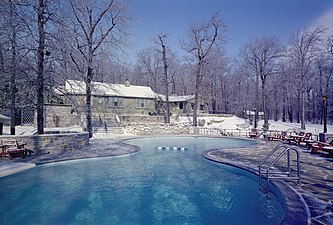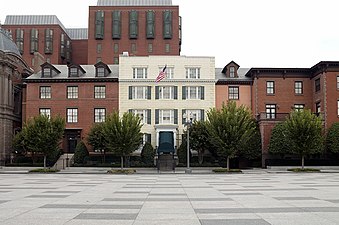Incumbency

Term limit
When the first president, George Washington, announced in his Farewell Address that he was not running for a third term, he established a "two-terms then out" precedent. Precedent became tradition after Thomas Jefferson publicly embraced the principle a decade later during his second term, as did his two immediate successors, James Madison and James Monroe. In spite of the strong two-term tradition, Ulysses S. Grant unsuccessfully sought a non-consecutive third term in 1880.
In 1940, after leading the nation through the Great Depression, Franklin Roosevelt was elected to a third term, breaking the long-standing precedent. Four years later, with the U.S. engaged in World War II, he was re-elected again despite his declining physical health; he died 82 days into his fourth term on April 12, 1945.
In response to the unprecedented length of Roosevelt's presidency, the Twenty-second Amendment was adopted in 1951. The amendment bars anyone from being elected president more than twice, or once if that person served more than two years (24 months) of another president's four-year term. Harry S. Truman, president when this term limit came into force, was exempted from its limitations, and briefly sought a second full term—to which he would have otherwise been ineligible for election, as he had been president for more than two years of Roosevelt's fourth term—before he withdrew from the 1952 election.
Since the amendment's adoption, five presidents have served two full terms: Dwight D. Eisenhower, Ronald Reagan, Bill Clinton, George W. Bush, and Barack Obama. Jimmy Carter, George H. W. Bush and Donald Trump each sought a second term but were defeated. Richard Nixon was elected to a second term, but resigned before completing it. Lyndon B. Johnson, having held the presidency for one full term in addition to only 14 months of John F. Kennedy's unexpired term, was eligible for a second full term in 1968, but he withdrew from the Democratic primary. Additionally, Gerald Ford, who served out the last two years and five months of Nixon's second term, sought a full term but was defeated by Jimmy Carter in the 1976 election.
Vacancies and succession
Under Section 1 of the Twenty-fifth Amendment, ratified in 1967, the vice president becomes president upon the removal from office, death, or resignation of the president. Deaths have occurred a number of times, resignation has occurred only once, and removal from office has never occurred.
The original Constitution, in Article II, Section 1, Clause 6, stated only that the vice president assumes the "powers and duties" of the presidency in the event of a president's removal, death, resignation, or inability. Under this clause, there was ambiguity about whether the vice president would actually become president in the event of a vacancy, or simply act as president, potentially resulting in a special election. Upon the death of William Henry Harrison in 1841, Vice President John Tyler declared that he had succeeded to the office itself, refusing to accept any papers addressed to the "Acting President," and Congress ultimately accepted it. This established a precedent for future successions, although it was not formally clarified until the Twenty-fifth Amendment was ratified.
In the event of a double vacancy, Article II, Section 1, Clause 6 also authorizes Congress to declare who shall become acting president in the "Case of Removal, Death, Resignation or Inability, both of the president and vice president". The Presidential Succession Act of 1947 (codified as 3 U.S.C. § 19) provides that if both the president and vice president have left office or are both otherwise unavailable to serve during their terms of office, the presidential line of succession follows the order of: speaker of the House, then, if necessary, the president pro tempore of the Senate, and then if necessary, the eligible heads of federal executive departments who form the president's cabinet. The cabinet currently has 15 members, of which the secretary of state is first in line; the other Cabinet secretaries follow in the order in which their department (or the department of which their department is the successor) was created. Those individuals who are constitutionally ineligible to be elected to the presidency are also disqualified from assuming the powers and duties of the presidency through succession. No statutory successor has yet been called upon to act as president.
Declarations of inability
Under the Twenty-fifth Amendment, the president may temporarily transfer the presidential powers and duties to the vice president, who then becomes acting president, by transmitting to the speaker of the House and the president pro tempore of the Senate a statement that he is unable to discharge his duties. The president resumes his or her powers upon transmitting a second declaration stating that he is again able. The mechanism was used once by Ronald Reagan and twice by George W. Bush, in all cases in anticipation of surgery.
The Twenty-fifth Amendment also provides that the vice president, together with a majority of certain members of the Cabinet, may transfer the presidential powers and duties to the vice president by transmitting a written declaration, to the speaker of the House and the president pro tempore of the Senate, to the effect that the president is unable to discharge his or her powers and duties. If the president then declares that no such inability exist, he or she resumes the presidential powers unless the vice president and Cabinet make a second declaration of presidential inability, in which case Congress decides the question.
Removal
Article II, Section 4 of the Constitution allows for the removal of high federal officials, including the president, from office for "treason, bribery, or other high crimes and misdemeanors". Article I, Section 2, Clause 5 authorizes the House of Representatives to serve as a "grand jury" with the power to impeach said officials by a majority vote. Article I, Section 3, Clause 6 authorizes the Senate to serve as a court with the power to remove impeached officials from office, by a two-thirds vote to convict.
Three presidents have been impeached by the House of Representatives: Andrew Johnson in 1868, Bill Clinton in 1998, and Donald Trump in 2019 and also in 2021; none have been convicted by the Senate. Additionally, the House Judiciary Committee conducted an impeachment inquiry against Richard Nixon in 1973–74; however, he resigned from office before the full House voted on the articles of impeachment.
Compensation
| Presidential pay history | ||
|---|---|---|
| Year established |
Salary | Salary in 2020 USD |
| 1789 | $25,000 | $736,000 |
| 1873 | $50,000 | $1,080,000 |
| 1909 | $75,000 | $2,135,000 |
| 1949 | $100,000 | $1,089,000 |
| 1969 | $200,000 | $1,412,000 |
| 2001 | $400,000 | $585,000 |
| Current | $400,000 | $400,000 |
| Sources: | ||
Since 2001, the president's annual salary has been $400,000, along with a: $50,000 expense allowance; $100,000 nontaxable travel account, and $19,000 entertainment account. The president's salary is set by Congress, and under Article II, Section 1, Clause 7 of the Constitution, any increase or reduction in presidential salary cannot take effect before the next presidential term of office.
Residence
The White House in Washington, D.C. is the official residence of the president. The site was selected by George Washington, and the cornerstone was laid in 1792. Every president since John Adams (in 1800) has lived there. At various times in U.S. history, it has been known as the "President's Palace", the "President's House", and the "Executive Mansion". Theodore Roosevelt officially gave the White House its current name in 1901. Facilities that are available to the president include access to the White House staff, medical care, recreation, housekeeping, and security services. The federal government pays for state dinners and other official functions, but the president pays for personal, family, and guest dry cleaning and food.
Camp David, officially titled Naval Support Facility Thurmont, a mountain-based military camp in Frederick County, Maryland, is the president's country residence. A place of solitude and tranquility, the site has been used extensively to host foreign dignitaries since the 1940s.
President's Guest House, located next to the Eisenhower Executive Office Building at the White House Complex and Lafayette Park, serves as the president's official guest house and as a secondary residence for the president if needed. Four interconnected, 19th-century houses—Blair House, Lee House, and 700 and 704 Jackson Place—with a combined floor space exceeding 70,000 square feet (6,500 m2) comprise the property.
- Presidential residences

White House, the official residence

Camp David, the official retreat

Blair House, the official guest house
Travel
The primary means of long-distance air travel for the president is one of two identical Boeing VC-25 aircraft, which are extensively modified Boeing 747 airliners and are referred to as Air Force One while the president is on board (although any U.S. Air Force aircraft the president is aboard is designated as "Air Force One" for the duration of the flight). In-country trips are typically handled with just one of the two planes, while overseas trips are handled with both, one primary and one backup. The president also has access to smaller Air Force aircraft, most notably the Boeing C-32, which are used when the president must travel to airports that cannot support a jumbo jet. Any civilian aircraft the president is aboard is designated Executive One for the flight.
For short-distance air travel, the president has access to a fleet of U.S. Marine Corps helicopters of varying models, designated Marine One when the president is aboard any particular one in the fleet. Flights are typically handled with as many as five helicopters all flying together and frequently swapping positions as to disguise which helicopter the president is actually aboard to any would-be threats.
For ground travel, the president uses the presidential state car, which is an armored limousine designed to look like a Cadillac sedan, but built on a truck chassis. The U.S. Secret Service operates and maintains the fleet of several limousines. The president also has access to two armored motorcoaches, which are primarily used for touring trips.
- Presidential transportation

The presidential limousine, dubbed "The Beast"

The presidential plane, called Air Force One when the president is on board

Marine One helicopter, when the president is aboard
Protection
The U.S. Secret Service is charged with protecting the president and the first family. As part of their protection, presidents, first ladies, their children and other immediate family members, and other prominent persons and locations are assigned Secret Service codenames. The use of such names was originally for security purposes and dates to a time when sensitive electronic communications were not routinely encrypted; today, the names simply serve for purposes of brevity, clarity, and tradition.






Comments
Post a Comment